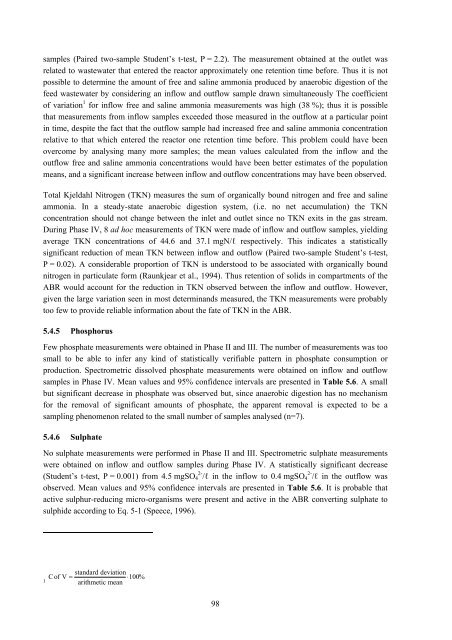analysis of a pilot-scale anaerobic baffled reactor treating domestic ...
analysis of a pilot-scale anaerobic baffled reactor treating domestic ...
analysis of a pilot-scale anaerobic baffled reactor treating domestic ...
You also want an ePaper? Increase the reach of your titles
YUMPU automatically turns print PDFs into web optimized ePapers that Google loves.
samples (Paired two-sample Student’s t-test, P = 2.2). The measurement obtained at the outlet was<br />
related to wastewater that entered the <strong>reactor</strong> approximately one retention time before. Thus it is not<br />
possible to determine the amount <strong>of</strong> free and saline ammonia produced by <strong>anaerobic</strong> digestion <strong>of</strong> the<br />
feed wastewater by considering an inflow and outflow sample drawn simultaneously The coefficient<br />
<strong>of</strong> variation 1 for inflow free and saline ammonia measurements was high (38 %); thus it is possible<br />
that measurements from inflow samples exceeded those measured in the outflow at a particular point<br />
in time, despite the fact that the outflow sample had increased free and saline ammonia concentration<br />
relative to that which entered the <strong>reactor</strong> one retention time before. This problem could have been<br />
overcome by analysing many more samples; the mean values calculated from the inflow and the<br />
outflow free and saline ammonia concentrations would have been better estimates <strong>of</strong> the population<br />
means, and a significant increase between inflow and outflow concentrations may have been observed.<br />
Total Kjeldahl Nitrogen (TKN) measures the sum <strong>of</strong> organically bound nitrogen and free and saline<br />
ammonia. In a steady-state <strong>anaerobic</strong> digestion system, (i.e. no net accumulation) the TKN<br />
concentration should not change between the inlet and outlet since no TKN exits in the gas stream.<br />
During Phase IV, 8 ad hoc measurements <strong>of</strong> TKN were made <strong>of</strong> inflow and outflow samples, yielding<br />
average TKN concentrations <strong>of</strong> 44.6 and 37.1 mgN/ℓ respectively. This indicates a statistically<br />
significant reduction <strong>of</strong> mean TKN between inflow and outflow (Paired two-sample Student’s t-test,<br />
P = 0.02). A considerable proportion <strong>of</strong> TKN is understood to be associated with organically bound<br />
nitrogen in particulate form (Raunkjear et al., 1994). Thus retention <strong>of</strong> solids in compartments <strong>of</strong> the<br />
ABR would account for the reduction in TKN observed between the inflow and outflow. However,<br />
given the large variation seen in most determinands measured, the TKN measurements were probably<br />
too few to provide reliable information about the fate <strong>of</strong> TKN in the ABR.<br />
5.4.5 Phosphorus<br />
Few phosphate measurements were obtained in Phase II and III. The number <strong>of</strong> measurements was too<br />
small to be able to infer any kind <strong>of</strong> statistically verifiable pattern in phosphate consumption or<br />
production. Spectrometric dissolved phosphate measurements were obtained on inflow and outflow<br />
samples in Phase IV. Mean values and 95% confidence intervals are presented in Table 5.6. A small<br />
but significant decrease in phosphate was observed but, since <strong>anaerobic</strong> digestion has no mechanism<br />
for the removal <strong>of</strong> significant amounts <strong>of</strong> phosphate, the apparent removal is expected to be a<br />
sampling phenomenon related to the small number <strong>of</strong> samples analysed (n=7).<br />
5.4.6 Sulphate<br />
No sulphate measurements were performed in Phase II and III. Spectrometric sulphate measurements<br />
were obtained on inflow and outflow samples during Phase IV. A statistically significant decrease<br />
(Student’s t-test, P = 0.001) from 4.5 mgSO4 2- /ℓ in the inflow to 0.4 mgSO4 2- /ℓ in the outflow was<br />
observed. Mean values and 95% confidence intervals are presented in Table 5.6. It is probable that<br />
active sulphur-reducing micro-organisms were present and active in the ABR converting sulphate to<br />
sulphide according to Eq. 5-1 (Speece, 1996).<br />
1<br />
standard deviation<br />
C <strong>of</strong> V =<br />
⋅100%<br />
arithmetic mean<br />
98
















